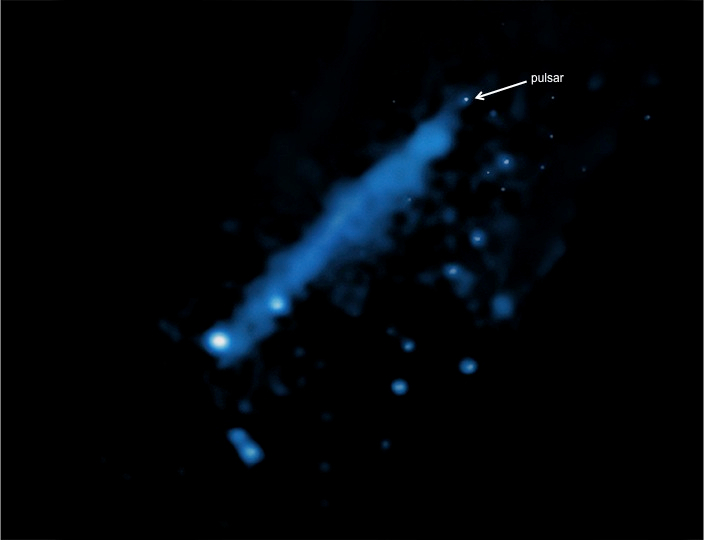
 Credit: NASA/CXC/IUSS/A.De Luca et al.
Credit: NASA/CXC/IUSS/A.De Luca et al.
A Pulsar's Tail
Pulsars are rapidly spinning neutron stars. Beams of radiation emitted near the magnetic poles of the neutron star sweep through space as the star rotates, and in fortuitous circumstances that beam may pass over earth, so that observations (in radio wavelengths, in optical, and/or in high energy X-ray or Gamma rays) will detect a steady pulsation of radiation. Pulsars are born in extremely violent supernova explosions, though no one quite knows how. Somehow some of the violence of this explosion gets transferred into the rapid spin of the neutron star. Sometimes this explosion may propel the neutron star through space. The image above is an X-ray picture from the Chandra X-ray Observatory of a pulsar known as PSR J0357+3205, an object discovered by the Fermi Gamma-ray Space Telescope from the regular variations in its Gamma ray emission. Chandra's excellent spatial resolution and high contrast imaging reveals a surprise, a long tail of X-ray emission trailing behind the pulsar, as shown above. Astronomers are debating the meaning of this tail: whether it's an X-ray "wake" produced by the motion of the neutron star through the Milky Way. Or is it a jet of material associated with the pulsar's magnetic field? Future images of the pulsar to determine how rapidly it's moving through space will resolve this controversy, and add another piece to the puzzle of the supernova death of massive stars.
Published: July 18, 2011
<
HEA Dictionary ● Archive
● Search HEAPOW
● Other Languages
● HEAPOW on Facebook
● Download all Images
● Education ● HEAD
>

Each week the HEASARC
brings you new, exciting and beautiful images from X-ray and Gamma ray
astronomy. Check back each week and be sure to check out the HEAPOW archive!
Page Author: Dr. Michael F. Corcoran
Last modified Monday, 26-Feb-2024 17:23:11 EST


